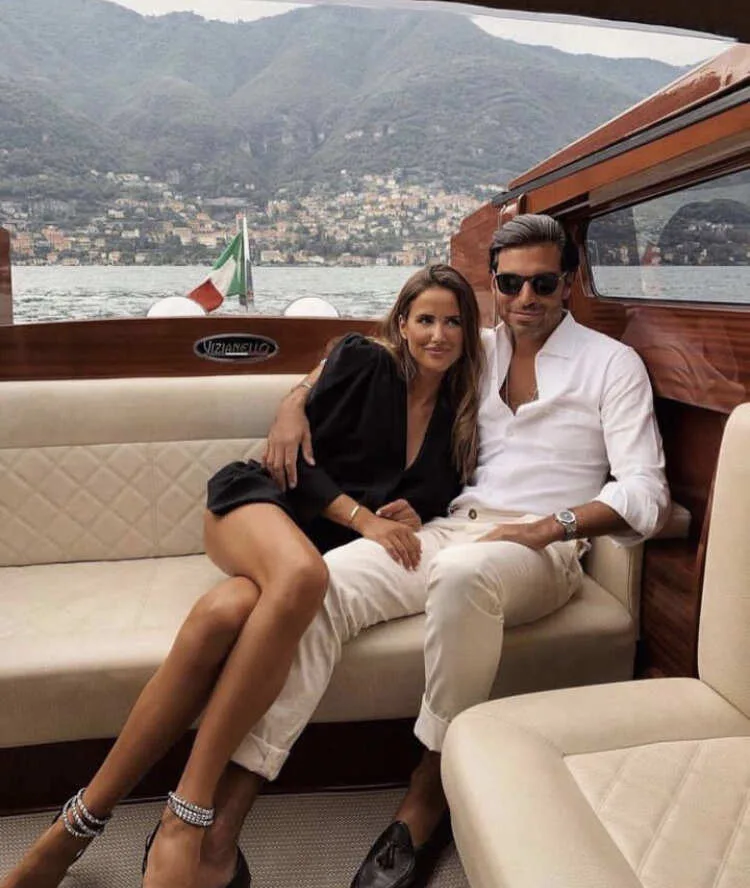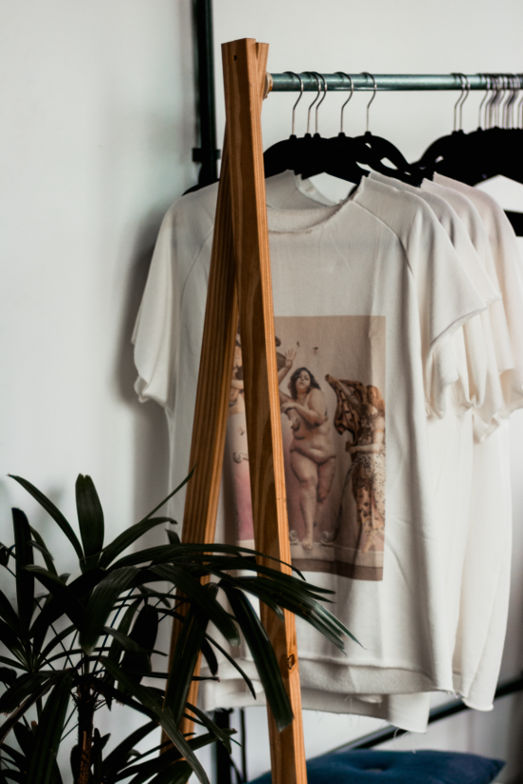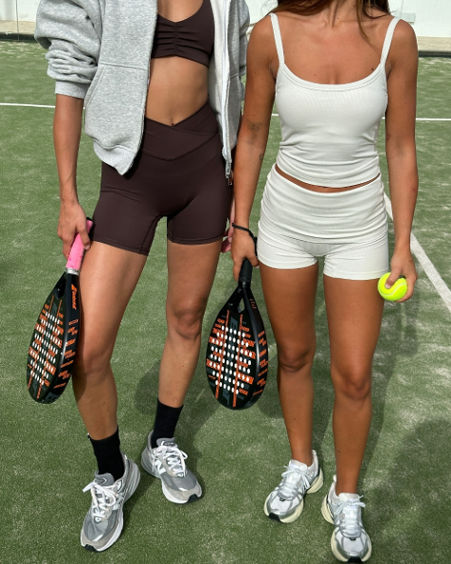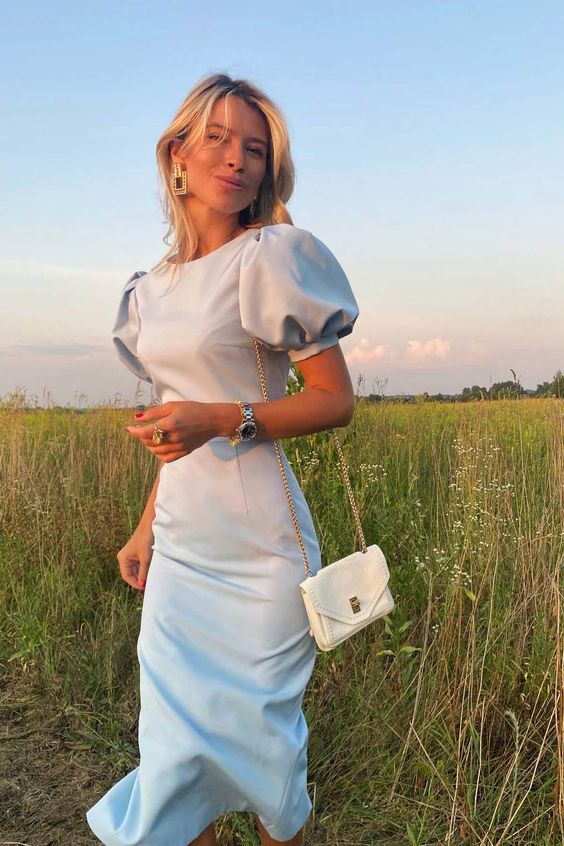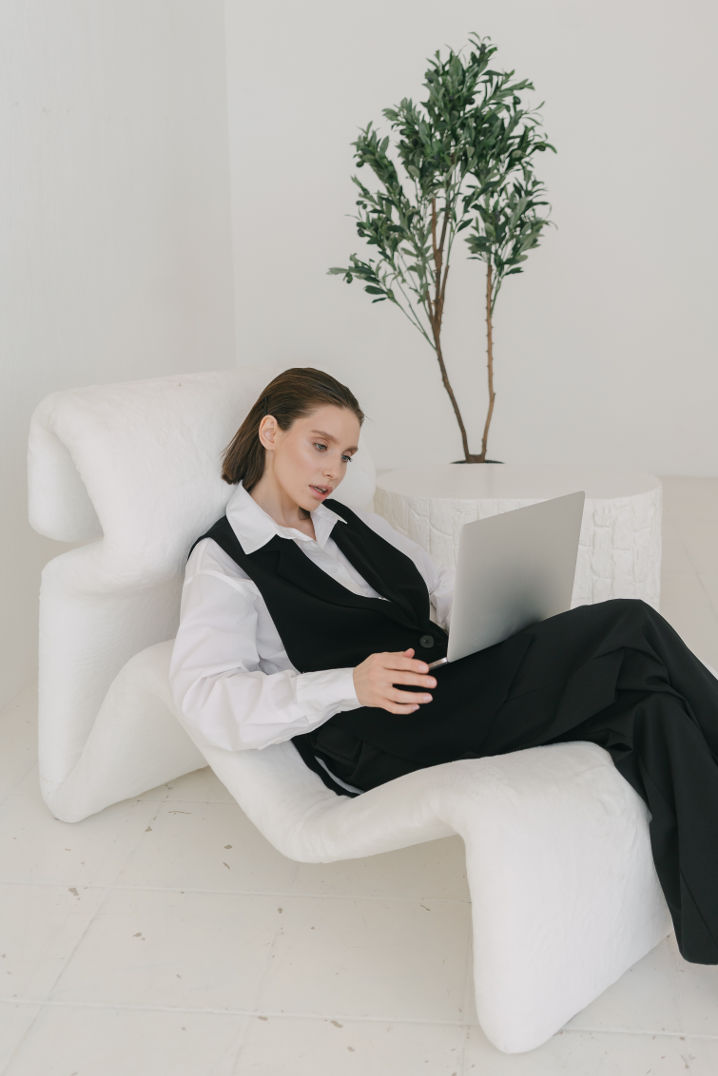Fashion is a dynamic industry known for its cyclical nature – hence Circular Fashion. Trends from the past often find their way back into the spotlight, creating a sense of nostalgia and freshness simultaneously.
In recent years, this phenomenon has taken on a new form with the rise of circular fashion, where sustainability meets style.
This comprehensive guide explores the world of circular fashion, the environmental benefits it offers, and the various fashion trends that have come full circle over the years. This is a great way to understadning why a Capsule Wardrobe should be the trend over fast fashion!
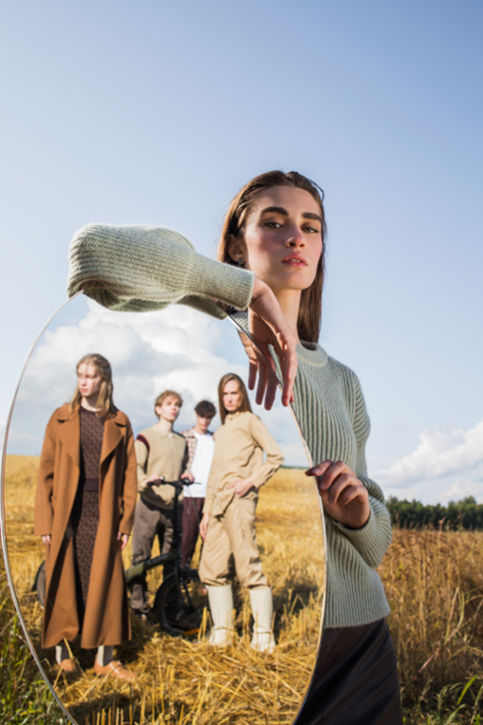
Let’s dive into the different areas this article will cover, from defining Circular Fashion to what the future will bring:
- Circular Fashion: Where Style Meets Sustainability
- 1. Understanding Circular Fashion
- 2. The Environmental Impact of Fast Fashion
- 3. Why Circular Fashion Matters
- 4. Fashion Trends Through the Decades
- 5. The Return of Vintage Styles
- 6. Circular Fashion Practices
- 7. Sustainable Brands and Thrifting
- 8. Upcycling and DIY Fashion
- 9. The Future of Circular Fashion
- Join the Circular Fashion Movement
Circular Fashion: Where Style Meets Sustainability
Circular fashion isn’t just a trend; it’s a fundamental shift in the way we approach clothing and style. This cornerstone article aims to shed light on the circular fashion movement and how it intersects with fashion trends from the past and present.
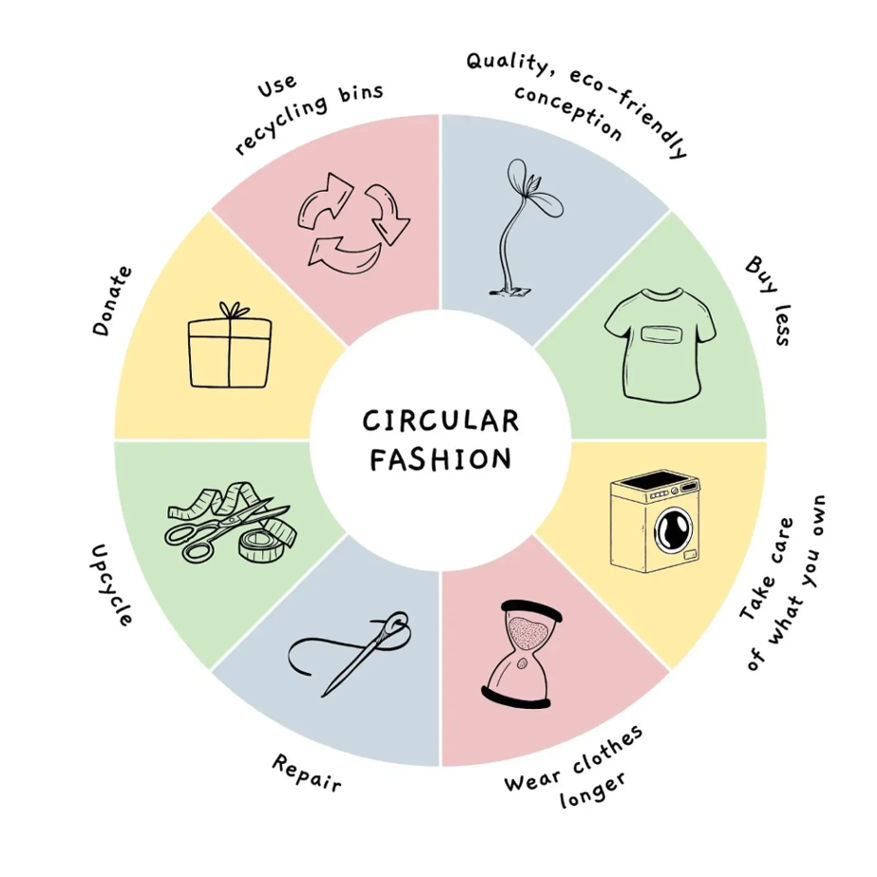
1. Understanding Circular Fashion
Let’s kick things off by diving into the heart of the matter—understanding circular fashion. It’s not just about clothing; it’s about reimagining the way we produce, consume, and repurpose fashion items, all within the context of sustainability.
So, why is this understanding so crucial? Well, think of it this way: you wouldn’t start a journey without knowing where you’re headed. In the world of fashion, knowing what circular fashion is sets the compass for a stylish, eco-conscious voyage.
Now, let’s embark on this journey of discovery. Imagine circular fashion as a loop, where resources are reused and repurposed, minimizing waste and environmental harm. It’s a break from the linear ‘take, make, dispose’ model that has plagued the fashion industry for far too long.
Here’s where the excitement comes in: circular fashion isn’t just about being kind to the planet; it’s about embracing an innovative and sustainable approach to style. It’s about looking fabulous while reducing your fashion footprint.
Picture a fashion world where old trends never really fade away; they simply take a breather and return with a fresh twist. Now, this is where the magic happens. Circular fashion not only minimizes waste but also gives new life to vintage styles. It’s like a fashion time machine where the past meets the future, and the result is uniquely stylish.
In this guide, we’re going to take you through the ins and outs of circular fashion. We’ll explore its significance, its role in redefining the industry, and how it breathes new life into bygone trends. So, fasten your seatbelts; this is going to be a stylish, sustainable journey you won’t want to miss.
But first, let’s start by understanding what exactly circular fashion entails.
2. The Environmental Impact of Fast Fashion
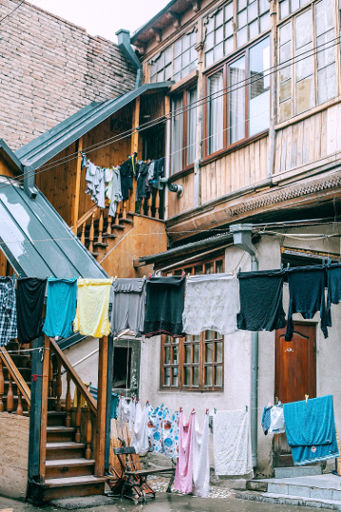
Before we plunge headfirst into the world of circular fashion, it’s crucial to grasp the stark reality of the environmental havoc wreaked by the fast fashion industry.
Imagine a world where clothes are produced at lightning speed, worn briefly, and then discarded. This is the hallmark of fast fashion. It’s a world where the need for the latest trends results in an unprecedented consumption frenzy.
But here’s the catch: this voracious appetite for fast, disposable fashion comes at an enormous environmental cost. We’re talking about a fashion industry that’s a significant contributor to pollution, resource depletion, and waste.
The Manufacturing Processes
Now, picture the lifecycle of your average fast fashion piece. From the extraction of raw materials like cotton and synthetic fibers to the energy-intensive manufacturing processes, and then the long-haul shipping; it’s a colossal energy drain. Add to that the frequent turnover of clothing, and you’ve got a perfect storm of waste.
And let’s not forget about the environmental impact of chemical dyes and finishes used in garment production. These substances often find their way into water bodies, wreaking havoc on aquatic ecosystems.
It’s not just pollution; fast fashion also has a dark side when it comes to social and ethical issues. Sweatshops, low wages, and poor working conditions are far too common in the race to churn out cheap, trendy clothes.
So, why are we telling you all this? It’s not to discourage you but to empower you with knowledge. Understanding the environmental toll of fast fashion is the first step towards making a change, towards embracing circular fashion.
Think of it as being aware of the storm before setting sail on calmer waters. Circular fashion is the lifeboat that rescues us from this storm, offering sustainable alternatives that keep us stylish and eco-conscious.
So, as we continue our journey through the realm of fashion sustainability, keep this sobering reality in mind. The environmental impact of fast fashion is the driving force behind the circular fashion movement, inspiring us to change our approach to clothing and style.
Now, let’s move forward with our voyage and explore why circular fashion matters so much in this context.
3. Why Circular Fashion Matters
It’s time to unravel the mystery behind why circular fashion isn’t just another buzzword but a pivotal force driving us towards a greener, more sustainable future.
Fashion trends may come and go, but the impact they have on our planet lingers far beyond the runway. Enter circular fashion, the antidote to the environmentally destructive practices of the industry.
So, why does Circular Fashion matter?
It matters because it’s about reimagining the entire fashion ecosystem. It’s about breaking free from the linear, resource-draining, and wasteful model that has prevailed for too long.
Circular fashion doesn’t just talk the talk; it walks the walk. It’s not content with making us look good; it also makes us feel good about our choices. Here’s how:
- Reducing Waste: Circular fashion takes the spotlight off landfills and puts it on reusing, recycling, and upcycling. It’s about extending the lifespan of our clothing, reducing waste, and lessening the burden on our planet.
- Preserving Resources: By recycling materials and repurposing old clothing, circular fashion conserves valuable resources like water and energy. It’s a lifeline for a planet in dire need of resource preservation.
- Economic Benefits: Circular fashion isn’t just a win for the environment; it’s a win for your wallet too. Investing in high-quality, durable pieces means you buy less often, ultimately saving you money.
- Reviving Vintage Styles: Remember those trends from yesteryears? Circular fashion breathes new life into them. It’s like a fashion time capsule, where the past meets the present with a modern twist.
- Reducing Carbon Footprint: By opting for circular fashion, you’re making a conscious choice to reduce your carbon footprint. Fewer new clothes mean fewer emissions associated with production and transportation.
- Promoting Ethical Practices: Circular fashion aligns with ethical manufacturing and fair labor practices. It champions the welfare of workers and challenges the exploitative norms of fast fashion.
Why Circular Fashion?
So, why does circular fashion matter? It matters because it’s a chance for us to redefine our relationship with fashion. It’s about style that doesn’t come at the planet’s expense. It’s about sustainable choices that make a difference.
In the following sections of this guide, we’ll delve deeper into the world of circular fashion, exploring its practices, showcasing sustainable brands, and even giving you the creative tools to upcycle your wardrobe. It’s all part of the journey towards a more sustainable and stylish future.
Now that you understand why circular fashion matters, let’s explore the fascinating world of fashion trends through the decades, where styles have a habit of making a triumphant return.
4. Fashion Trends Through the Decades
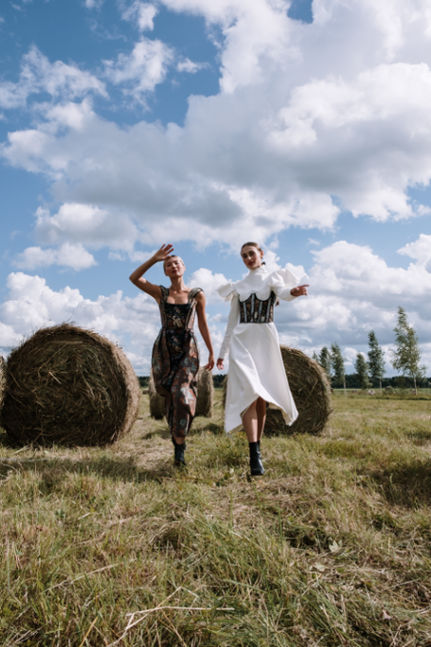
Buckle up, because we’re about to embark on a thrilling journey through time, unraveling the most iconic fashion trends from the 20th century right up to today. It’s a captivating tale of how styles evolve, adapt, and sometimes, even come full circle.
The Roaring Twenties (1920s)
The Jazz Age roared into fashion history with flapper dresses, dropped waists, and extravagant headpieces. Hemlines rose, and women embraced a newfound freedom in their clothing.
The Glamorous Thirties (1930s)
The Great Depression didn’t dampen the fashion spirit. Bias-cut gowns, wide shoulders, and tailored suits defined this era, capturing the essence of old Hollywood glamour.
The Post-War Forties (1940s)
World War II influenced fashion with utility-inspired attire. Think high-waisted trousers, shoulder pads, and platform shoes. It was all about practicality and patriotism.
The Fabulous Fifties (1950s)
The ’50s ushered in the era of poodle skirts, full-circle skirts, and the iconic hourglass silhouette. It was a time of elegance, with women embracing cinched waists and men donning sharp suits.
The Swinging Sixties (1960s)
With the Beatles taking over the airwaves, the ’60s brought miniskirts, shift dresses, and bold, psychedelic prints. Youth culture and rebellion took center stage in fashion.
The Groovy Seventies (1970s)
Hippie counterculture influenced the ’70s with bell-bottom pants, peasant blouses, and the revival of bohemian styles. Disco fever also gave rise to flashy, glamorous attire.
The Preppy Eighties (1980s)
The ’80s were all about power dressing. Shoulder pads, bold colors, and statement accessories defined this era. It was a time of excess and extravagance.
The Grunge Nineties (1990s)
Grunge emerged as an anti-fashion statement. Think flannel shirts, ripped jeans, and combat boots. It was a rebellion against the glitz and glamour of the ’80s.
The New Millennium (2000s)
The 2000s were a mix of styles, from low-rise jeans and belly-button piercings to velour tracksuits. It was a decade of experimentation and individualism.
The 2010s and Beyond
The last decade witnessed a fusion of past trends with modern minimalism. Normcore, athleisure, and sustainable fashion became buzzwords. It was a shift towards simplicity and consciousness.
Now, what’s fascinating about these trends is that many of them haven’t disappeared; they’ve evolved and, in some cases, come back stronger than ever. This cyclical nature of fashion is where circular fashion comes into play.
The essence of circular fashion lies in extending the life of these iconic trends by reimagining and repurposing them. So, as we continue this journey, you’ll see how circular fashion breathes new life into styles of the past, creating a sustainable and stylish future.
But before we delve further into this fashion revolution, let’s explore the revival of vintage styles in the context of circular fashion, where the past meets the present with a modern twist.
5. The Return of Vintage Styles
Get ready to be transported through time as we uncover how vintage fashion has not only made a stunning comeback but is also a testament to the cyclical nature of trends. It’s a journey where the past meets the present with a contemporary twist, proving that what goes around in fashion truly comes back around.
The Timeless Appeal of Vintage
Vintage fashion is like a treasure trove of styles from bygone eras. It encompasses clothing and accessories that are at least 20 years old, each piece with its unique story and charm. What sets vintage apart is its enduring appeal. Styles from the past hold a certain allure, a hint of nostalgia, and often, a touch of elegance that transcends time.
Why Vintage Fashion Matters
But why has vintage fashion seen such a resurgence in recent years? Well, several factors contribute to its newfound popularity:
- Sustainability: As we’ve explored earlier, the fashion industry’s environmental footprint is a growing concern. Vintage fashion, with its focus on reuse and repurposing, aligns perfectly with the principles of circular fashion.
- Individuality: In a world of mass-produced clothing, vintage offers a chance to stand out. It allows individuals to express their unique style and personality.
- Quality Craftsmanship: Many vintage pieces were crafted with exquisite attention to detail and high-quality materials, making them more durable than some of their modern counterparts.
- Time-Tested Styles: Trends often repeat themselves, and vintage fashion showcases styles that have stood the test of time, proving their enduring appeal.
Reviving Vintage Trends
One of the most exciting aspects of vintage fashion is how it seamlessly integrates with contemporary styles. Fashion designers and enthusiasts are constantly drawing inspiration from the past to create fresh, modern looks.
For instance, you might see a ’70s-inspired jumpsuit or a ’90s grunge-inspired plaid shirt on the runway or at your favorite clothing store. These pieces capture the essence of their respective eras while adding a modern twist, proving that fashion trends have a way of making a triumphant return.
The revival of vintage styles is not limited to high fashion; it has also become a staple in everyday wardrobes. Thrift stores and online vintage boutiques are thriving, offering a wide array of unique, sustainable fashion options.
As you navigate the world of circular fashion, vintage clothing becomes a key player. By embracing vintage pieces, you not only reduce your fashion footprint but also add a touch of timeless elegance to your wardrobe. It’s a win-win situation that perfectly encapsulates the intersection of style and sustainability.
In the following sections of this guide, we’ll explore circular fashion practices, sustainable brands, and even creative ways to upcycle your clothing. It’s all part of the journey towards a more sustainable and stylish future, where vintage styles blend harmoniously with modern sensibilities. So, let’s continue our voyage of discovery.
Explore practical tips for adopting circular fashion practices in your daily wardrobe choices.
6. Circular Fashion Practices
Your Wardrobe’s Sustainable Transformation. Unlock the secrets to a more sustainable wardrobe with these practical tips for embracing circular fashion.
1. Closet Cleanse: Start by decluttering your closet and donating or selling items you no longer wear. This step not only reduces waste but also makes room for new, eco-friendly additions.
2. Quality Over Quantity: Invest in high-quality, timeless pieces that can withstand the test of time. Think versatile basics and classic styles that won’t go out of fashion.
3. Repair and Restore: Before tossing a damaged item, consider repairing it or taking it to a tailor. Simple fixes can extend the life of your clothing.
4. Swap and Share: Organize clothing swaps with friends or join online communities where you can exchange items. It’s a fun way to refresh your wardrobe without buying new.
5. Secondhand Treasures: Explore thrift stores, vintage shops, and online secondhand marketplaces for unique and sustainable fashion finds.
6. Rent for Special Occasions: Instead of buying a dress you’ll only wear once, rent it for special events. Many rental services offer designer options at a fraction of the price.
7. Mindful Laundering: Extend the life of your clothing by washing them with care. Use cold water, eco-friendly detergents, and air-dry when possible to reduce energy consumption.
8. Recycle Responsibly: When clothing reaches the end of its wearable life, recycle it through proper channels. Many brands and organizations have recycling programs in place.
By incorporating these circular fashion practices into your daily life, you not only reduce your fashion footprint but also cultivate a wardrobe that aligns with your style and values. It’s a journey towards a more sustainable and stylish future.
7. Sustainable Brands and Thrifting
Prepare to step into a world where fashion meets sustainability, as we unveil a treasure trove of sustainable fashion brands and thrift stores. Here, you’ll discover the keys to unlocking unique, eco-friendly pieces that not only elevate your style but also reduce your carbon footprint.
The Rise of Sustainable Fashion Brands
In a world increasingly aware of its environmental impact, sustainable fashion brands have risen to the occasion. These companies prioritize eco-conscious practices, ethical sourcing, and high-quality materials to create clothing that’s as kind to the planet as it is to your style.
Why opt for sustainable brands? Here’s why:
- Eco-Friendly Materials: Sustainable brands often use organic, recycled, or upcycled materials, reducing the need for resource-intensive production processes.
- Ethical Practices: Many sustainable brands champion fair labor practices and transparent supply chains, ensuring that workers are treated ethically and paid fairly.
- Durability: Sustainability and durability go hand in hand. Sustainable fashion is built to last, reducing the frequency of replacements and, in turn, lessening waste.
- Innovation: These brands are at the forefront of innovative eco-friendly technologies, creating fashion that pushes the boundaries of style and sustainability.
Thrift Stores: A World of Circular Fashion
Now, let’s talk about thrifting, a beloved practice that has made vintage and secondhand fashion more accessible than ever. Thrift stores are treasure troves where you can uncover unique pieces with stories to tell. Here’s what makes thrifting so appealing:
- Unique Finds: Thrift stores offer one-of-a-kind items that you won’t find in mainstream fashion outlets. Each piece has character and history.
- Affordability: Thrifting is budget-friendly. You can score designer labels and high-quality pieces at a fraction of their original cost.
- Sustainability: By shopping secondhand, you extend the lifespan of clothing, reducing the demand for new production and curbing fashion’s environmental impact.
- Creative Freedom: Thrifting allows you to experiment with your style without breaking the bank. Mix and match to create unique looks that reflect your personality.
If you’re dreaming of visiting some thrift stores, these are our favourite ones in Berlin, Menton, Marseille, and Vienna!
Finding Sustainable Brands and Thrift Stores
Now that you understand the value of sustainable brands and thrifting, you might be wondering how to start your journey towards eco-friendly style. Here are some tips:
- Research Sustainable Brands: Look for brands that align with your values and style preferences. Many have online stores, making it convenient to explore their collections.
- Visit Local Thrift Shops: Explore local thrift stores in your area. You’ll be amazed at the hidden gems you can uncover.
- Online Thrifting: Numerous online platforms, such as vintage marketplaces and secondhand boutiques, offer a wide range of pre-loved clothing and accessories.
- Sustainable Fashion Apps: Consider using apps and websites that specialize in sustainable and ethical fashion. They often curate a selection of eco-friendly brands and vintage finds.
By incorporating sustainable brands and thrifting into your fashion journey, you not only reduce your ecological footprint but also add a touch of uniqueness to your style. It’s a win-win situation that lets you embrace both fashion and sustainability.
In the following sections of this guide, we’ll delve deeper into the world of upcycling and DIY fashion, providing you with creative tools to breathe new life into your clothing and accessories. It’s all part of our mission to guide you towards a more sustainable and stylish future. So, let’s continue our exploration.
8. Upcycling and DIY Fashion
Prepare to embark on a creative journey where you’ll learn how to breathe new life into old clothing items. Upcycling and DIY fashion aren’t just about sustainable choices; they’re your canvas for self-expression. Let’s dive into the world of transformation and style.
The Art of Upcycling
Upcycling is the process of repurposing old clothing and accessories into something fresh and trendy. It’s a sustainable practice that allows you to embrace your inner designer and reduce waste. Here’s why it’s so appealing:
- Sustainability: Upcycling extends the lifespan of clothing, reducing the need for new production and minimizing waste.
- Creativity: It’s a playground for your imagination. You can customize and redesign items to reflect your unique style.
- Individuality: Upcycled pieces are one-of-a-kind. You won’t find duplicates on the racks, giving you a chance to stand out.
Getting Started with Upcycling Fashion
Wondering how to get started with upcycling? Here are some beginner-friendly ideas:
- Patchwork: Add patches or fabric scraps to jeans, jackets, or bags for a boho-chic look.
- Dyeing: Revive faded or discolored clothing by dyeing them in vibrant colors.
- Embellishments: Sew on beads, sequins, or embroidery to give plain items a touch of glamour.
- Cutting and Cropping: Transform oversized shirts into crop tops or create shorts from old jeans.
- Prints and Stencils: Use fabric paint or stencils to add unique patterns to plain garments.
The Magic of DIY Fashion
DIY fashion encompasses a wide range of creative projects, from crafting accessories to making your own clothing from scratch. It’s a way to put your skills to use and tailor fashion to your liking. Here’s why DIY fashion is so captivating:
- Customization: Create pieces that fit your body perfectly and express your personality.
- Skill Development: Learn valuable sewing, knitting, or crafting skills that can save you money and provide a sense of accomplishment.
- Sustainability: By making your own clothing, you have control over the materials used, ensuring they align with your sustainability goals.
Starting Your DIY Journey
If you’re new to DIY fashion, don’t worry; it’s all about experimentation. Here’s how to begin:
- Select Simple Projects: Start with straightforward projects like scarves, tote bags, or simple skirts.
- Learn the Basics: Familiarize yourself with essential sewing techniques, knitting stitches, or jewelry-making methods through online tutorials or classes.
- Gather Supplies: Collect the materials and tools you’ll need for your chosen project.
- Inspiration: Explore DIY fashion blogs, YouTube channels, and Pinterest boards for inspiration and tutorials.
By upcycling and diving into DIY fashion, you not only reduce your fashion footprint but also unleash your creativity and individuality. It’s about turning the old into something exciting and uniquely yours.
In the upcoming sections of this guide, we’ll explore sustainable fabrics and materials, showcasing the eco-friendly side of fashion. We’ll also delve into the latest sustainable fashion trends, proving that style and sustainability go hand in hand. So, let’s continue our journey towards a more sustainable and stylish future.
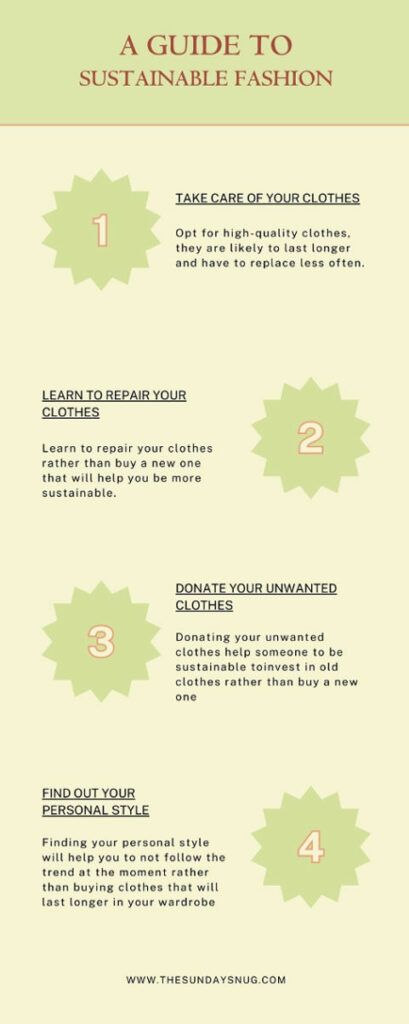
9. The Future of Circular Fashion
It’s time to turn our gaze toward the horizon and envision the future of fashion. In this final section, we’ll explore how circular principles are poised to reshape the entire industry. By the end of this guide, you’ll have a front-row seat to the fashion revolution and understand how circular fashion isn’t just a trend but a transformative force. If you want to nerd more into the science and date behind it, make sure to read additional material!
Redefining Fashion’s DNA
As we’ve journeyed through the world of circular fashion, you’ve likely discovered that it’s not just about stylish clothing; it’s about embracing a new way of thinking and living. Circular fashion represents a fundamental shift in how we produce, consume, and cherish our garments.
So, what does the future hold for this revolutionary approach to fashion?
1. Sustainable Innovation
In the coming years, we can expect to see an explosion of sustainable innovations. From fabrics created from agricultural waste to 3D-printed clothing, the fashion industry will continue to explore groundbreaking ways to reduce its environmental impact.
2. Circular Business Models
Circular fashion isn’t just about clothing; it’s a shift in business models. Brands will increasingly adopt practices like clothing rentals, garment leasing, and take-back programs. This means you’ll have more options for sustainable fashion experiences.
3. Digital Fashion
The digital realm will play a more significant role in fashion, with virtual clothing and digital fashion shows becoming the norm. This shift can help reduce the carbon footprint associated with physical production and transportation.
4. Transparency and Accountability
Consumers are demanding transparency from fashion brands. In response, companies will need to provide more information about their supply chains, labor practices, and environmental impact. This transparency will empower consumers to make informed choices.
5. Circular Communities
Circular fashion won’t just be a concept; it’ll be a way of life. Communities and platforms that facilitate clothing swaps, upcycling workshops, and sustainable fashion discussions will thrive, fostering a sense of collective responsibility.
Join the Circular Fashion Movement
By the end of this guide, you’ve gained a comprehensive understanding of circular fashion, its environmental benefits, and how fashion trends have a way of returning in style. Now, you have the knowledge to be a part of the circular fashion movement, contributing to a more sustainable, trend-conscious world.
Remember, it’s not just about embracing circular fashion because it’s a trend; it’s about embracing a more responsible and eco-conscious way of life. As you make sustainable fashion choices, you become an advocate for positive change in an industry that has the power to shape our world.
So, let’s step boldly into the future of fashion, where circular principles guide our choices, making style and sustainability the ultimate partnership. Your journey towards a more sustainable and stylish world is just beginning, and it holds the promise of a brighter, greener future for us all.

